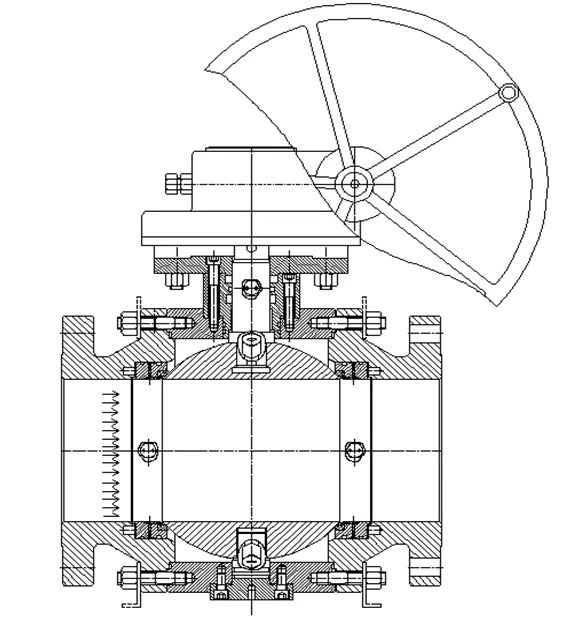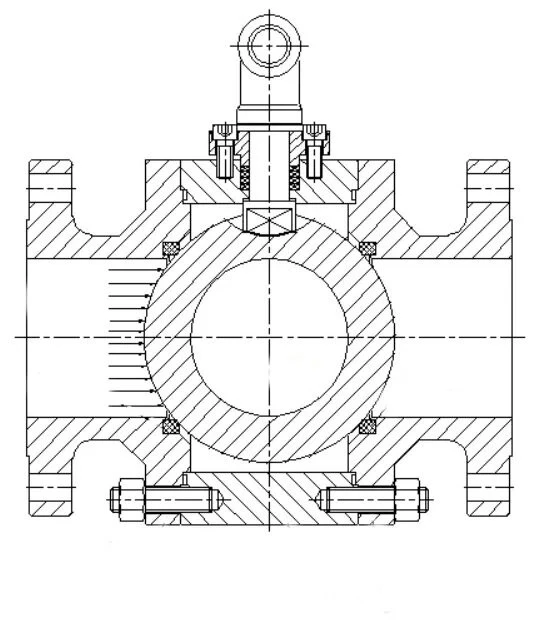Sealing Mechanisms in Floating and Trunnion Mounted Ball Valves
Dec 08, 2023
The sealing mechanisms within ball valve is crucial for achieving efficient fluid control. Two noteworthy players in this realm are the Floating Ball Valves and Trunnion Mounted Ball Valves. Each possesses distinctive designs that confer specific advantages, making these ball valves well-suited for diverse applications.
Sealing Principles of Trunnion Mounted Ball Valve
Trunnion mounted ball valves are primarily used in high-pressure and large-diameter valve applications, and their sealing principles can be categorized into two structures based on the installation of the seat sealing ring: front-sealing and rear-sealing of the ball.

2. Floating Ball Valve Sealing Principles
Floating ball valves feature two seat sealing rings within the valve body, clamping a floating ball with a through-hole. If the hole diameter matches the pipeline's inner diameter, it is referred to as a full-bore ball valve; if slightly smaller, it is a reduced-bore ball valve. The ball can freely rotate with the help of the valve stem. During opening, the ball hole aligns with the pipeline hole to minimize resistance. When the stem rotates a quarter turn, the ball hole becomes perpendicular to the channel. The ball is tightly pressed against the outlet-side seat sealing ring by pre-tension and medium pressure, ensuring complete sealing. This type of ball valve falls under the category of single-side forced sealing.

3. Considerations and Cautions for Floating Ball Valve
When using floating ball valves, consideration must be given to whether the seat material can withstand the load applied by the ball, which carries the full load of the working medium and transfers it to the seat.
In conclusion, trunnion mounted ball valves and floating ball valves exhibit differences in sealing principles and structures. The selection of the appropriate valve type should consider specific application scenarios and requirements.
Sealing Principles of Trunnion Mounted Ball Valve
Trunnion mounted ball valves are primarily used in high-pressure and large-diameter valve applications, and their sealing principles can be categorized into two structures based on the installation of the seat sealing ring: front-sealing and rear-sealing of the ball.

1. Front-Sealing of the Ball
In the front-sealing design of trunnion mounted ball valves, the seat sealing ring is installed at the front of the ball within the valve structure. During operation, the seat sealing ring at the inlet is pressurized by the medium, creating a seal against the ball and achieving sealing at the inlet. This sealing mechanism is commonly applied in high-pressure and large-diameter ball valve systems, offering a simple and effective working principle. The front-sealing structure demonstrates excellent performance in general pipeline systems and is a prevalent design choice for trunnion mounted ball valves.
2. Rear-Sealing of the Ball
In the rear-sealing design of trunnion mounted ball valves, the seat sealing ring is installed at the rear of the ball. When the valve is closed, the seat sealing ring is pushed towards the rear of the ball, creating an effective seal. This design is often employed in special conditions such as high-temperature and high-pressure environments, ensuring superior sealing performance. The rear-sealing design helps prevent media leakage and plays a crucial role in engineering applications with stringent requirements. When selecting a rear-sealing structure, thorough consideration of working conditions and media characteristics is essential to ensure the valve's reliability and long-term durability.
In the front-sealing design of trunnion mounted ball valves, the seat sealing ring is installed at the front of the ball within the valve structure. During operation, the seat sealing ring at the inlet is pressurized by the medium, creating a seal against the ball and achieving sealing at the inlet. This sealing mechanism is commonly applied in high-pressure and large-diameter ball valve systems, offering a simple and effective working principle. The front-sealing structure demonstrates excellent performance in general pipeline systems and is a prevalent design choice for trunnion mounted ball valves.
2. Rear-Sealing of the Ball
In the rear-sealing design of trunnion mounted ball valves, the seat sealing ring is installed at the rear of the ball. When the valve is closed, the seat sealing ring is pushed towards the rear of the ball, creating an effective seal. This design is often employed in special conditions such as high-temperature and high-pressure environments, ensuring superior sealing performance. The rear-sealing design helps prevent media leakage and plays a crucial role in engineering applications with stringent requirements. When selecting a rear-sealing structure, thorough consideration of working conditions and media characteristics is essential to ensure the valve's reliability and long-term durability.
2. Floating Ball Valve Sealing Principles
Floating ball valves feature two seat sealing rings within the valve body, clamping a floating ball with a through-hole. If the hole diameter matches the pipeline's inner diameter, it is referred to as a full-bore ball valve; if slightly smaller, it is a reduced-bore ball valve. The ball can freely rotate with the help of the valve stem. During opening, the ball hole aligns with the pipeline hole to minimize resistance. When the stem rotates a quarter turn, the ball hole becomes perpendicular to the channel. The ball is tightly pressed against the outlet-side seat sealing ring by pre-tension and medium pressure, ensuring complete sealing. This type of ball valve falls under the category of single-side forced sealing.

3. Considerations and Cautions for Floating Ball Valve
When using floating ball valves, consideration must be given to whether the seat material can withstand the load applied by the ball, which carries the full load of the working medium and transfers it to the seat.
- The sealing pressure ratio on the contact surface between the seat and the ball should be sufficiently high but within the allowable pressure ratio of the seat material.
- Even with good sealing properties between the seat and the ball, it is necessary to ensure tight coordination in the seat groove to prevent media leakage along the groove end face.
- The ball should have the correct geometric shape and low surface roughness, typically manufactured with an h6 or h7 precision, and a surface roughness not exceeding R0.4. Hardening treatment can be applied to enhance surface hardness and wear resistance.
- Seat materials, such as polytetrafluoroethylene (PTFE), can be used to ensure effective sealing with the ball and provide sufficient strength to withstand high sealing pressure ratios.
In conclusion, trunnion mounted ball valves and floating ball valves exhibit differences in sealing principles and structures. The selection of the appropriate valve type should consider specific application scenarios and requirements.
Next: Trunnion Mounted Ball Valve: A Breakthrough in High-Performance Valve Technology
Previous: High Pressure/Temperature Forged Valves for Power Plants
About Us
Categories
Useful Links
Our Contacts
Building 2, NO.59, Songshan Road, SND, Suzhou, China
